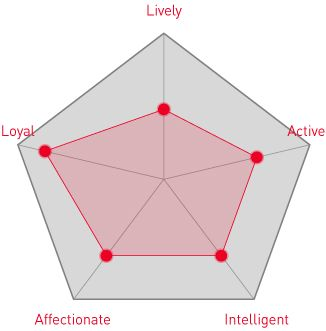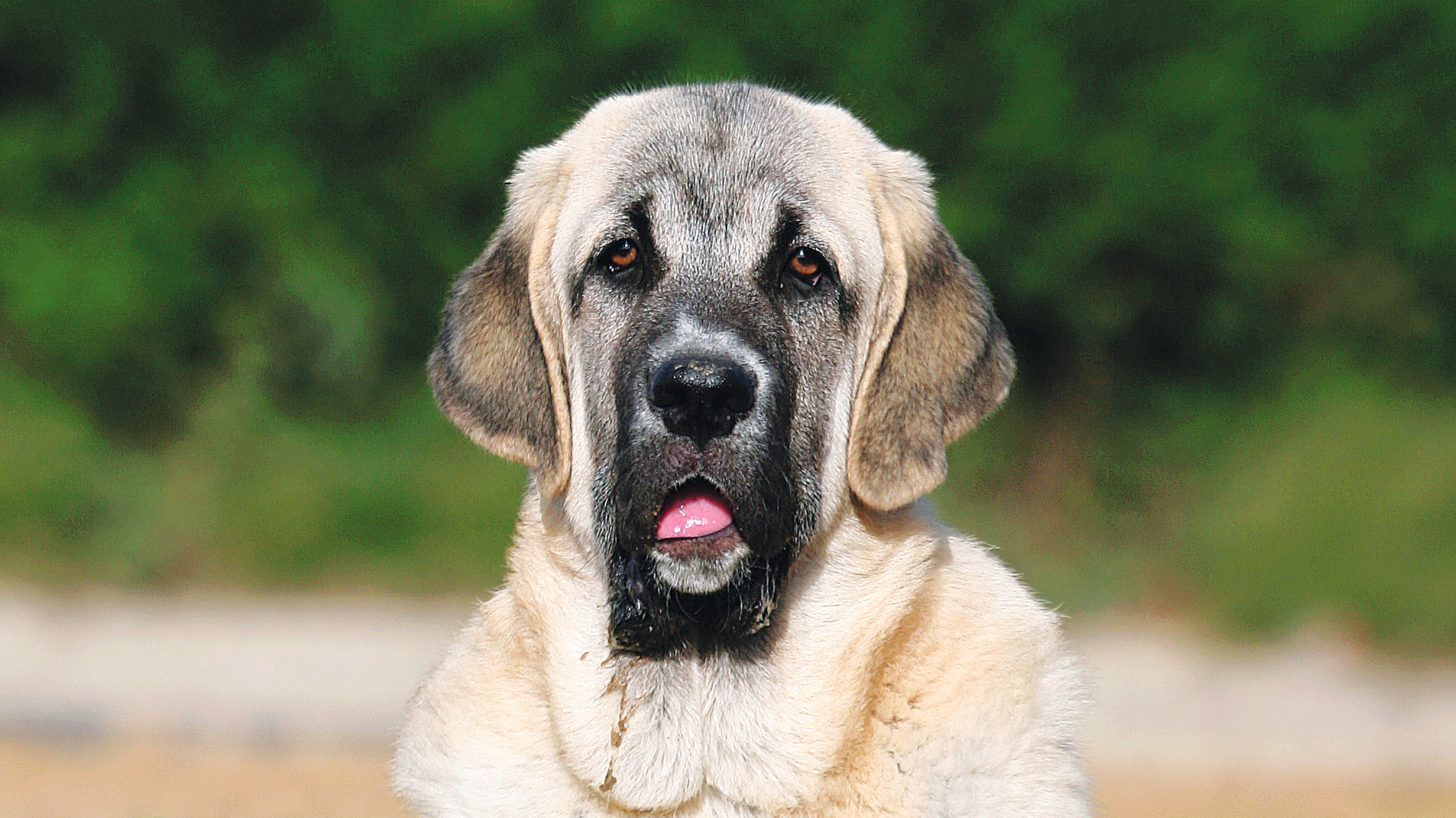
Let's talk Spanish Mastiffs
With a 2,000-year history closely intertwined with that of Spain’s livestock migrations, the Spanish Mastiff is a noble, giant breed renowned for courage and loyalty that have earned them a solid reputation as formidable guard dogs. Still used to protecting livestock and their families’ homes, Spanish Mastiffs are also warm-hearted and affectionate companions. However, with adult Spanish Mastiffs weighing in at a minimum of 110 pounds (50kg), they’re clearly not lap dogs. Given this and their booming bark, the Spanish Mastiff is a gentle giant better suited to rural life.
Official name: Spanish Mastiff
Other names: Mastín Español, Mastín de España
Origins: Spain

| Drooling tendencies: |  |
Warm weather? |  |
| Shedding level: |  |
Suited to apartment living? |  |
| Energy needs (high, low, medium) *: | Medium | Family pet? * |  |
| Compatibility with other pets: |  |
Can stay alone? * |  |
* We advise against leaving pets alone for long stretches. Companionship can prevent emotional distress and destructive behaviour. Speak to your veterinarian for recommendations.
Every pet is different, even within a breed; this snapshot of this breed’s specifics should be taken as an indication.
For a happy, healthy and well-behaved pet, we recommend educating and socialising your pet as well as covering their basic welfare, social and behavioural needs.
Pets should never be left unsupervised with a child.
All domestic pets are sociable and prefer company. However, they can be taught to cope with solitude from an early age. Seek the advice of your veterinarian or trainer to help you do this.


| Baby age: | Birth to 2 months |
| Puppy age: | 2 to 8 months |
| Junior age: | 8 months to 2 years |
| Adult age: | 2 to 5 years |
| Mature age: | 5 to 7 years |
| Senior age: | 7 years+ |

1/7
Origins of the breed
For many enthusiasts, the Labrador Retriever remains one of the most popular all-round dogs worldwide. It’s thought that Labrador Retrievers originated from the coast of Newfoundland, Canada, where fishermen used dogs of this appearance to retrieve fish. The breed as we know it today, however, was established by the British in the early 1800’s.
The Labrador Retriever Club was founded in 1916 and the first standard followed soon after, predominantly tailored to working Labrador Retrievers who found early fame, having been originally introduced to the U.K. in the late 1800’s by Col Peter Hawker and the Earl of Malmesbury.

2/7
2 facts about Spanish Mastiffs
1. The accidental star
Though not overly keen on the limelight, Spanish Mastiffs have enjoyed significant attention over the centuries thanks to their hard work and loyalty. So important was their role in Spanish history that they were featured in renowned works of art including Diego Velàzquez’s famous painting “Las Meninas”. Completed in 1656, the work depicts a Spanish Mastiff lying peacefully alongside a group of children. When in Madrid, visit it at the Museo del Prado.
2. What’s in a name?
The word “mastiff” refers to ancient, large and powerful breeds favoured as guard dogs in the Middle Ages. The word mastiff actually comes from the Old French “mastin” or Provencal “mastis”. But if we go back even farther, these two last terms are thought to come from the Vulgar Latin term masuetus, meaning domesticated and gentle! Etymologically speaking, the term mastiff would then mean a large breed of dog that stays in the home as a watchdog. So, when you’re talking about the Spanish Mastiff, you now know exactly what you’re getting!
History of the breed
An ancient breed, the Spanish Mastiff was present on the Iberian Peninsula prior to the Roman invasion and is thought to have been brought over by Greeks and Phoenicians from India or Syria.
By the Middle Ages, Spain had emerged as a prime wool production centre, and had begun breeding merinos, a new kind of sheep that produced superior wool. The Spanish Shepherds Association, the Mesta, created the oldest written records about this breed, with documents from the 15th century citing the Spanish Mastiff’s invaluable role in protecting valuable flocks from large predators.
One document dating from 1526 tells of 3.5 million sheep being herded across Spain in the company of Spanish Mastiffs and shepherds. Not at one time, of course. Such regular mass migrations left an indelible mark on Spanish culture, cementing the Spanish Mastiff’s important role in the nation’s history, earning them mention in literary works and appearances in famous paintings.
By the 20th century, Spanish Mastiffs could be seen in dog shows; however, they didn’t get their official breed standard until 1946. Today, Spanish Mastiffs continue to enjoy popularity as working dogs and pets in their home country and have earned the status of national dog.

4/7
From head to tail
Physical characteristics of Spanish Mastiffs
1. Head
Broad, well-proportioned head with strong jaws.
2. Ears
Relatively small, almond-shaped eyes with attentive expression.
3. Neck
Neck is broad and muscled with a double dewlap.
4. Body
Rectangular, well-muscled body with massive chest.
5. Tail
Fringed tail is thick at root and carried low.

5/7
Things to look out for
From specific breed traits to a general health overview, here are some interesting facts about your Spanish Mastiff

6/7
Caring for your Spanish Mastiff
Grooming, training and exercise tips
Aside from shedding heavily twice a year – big dog, lot of hair – and fully blowing their coat in spring, the Spanish Mastiff has a double coat that can be maintained with frequent brushing and the occasional bath to keep odours at bay. But be sure to have some wipes handy since these dogs drool. Also, keep nails trimmed, check and clean their ears regularly, and establish a solid dental routine.
Despite being huge and content to laze about and cuddle, Spanish Mastiffs are surprisingly agile and athletic. Make sure they get a couple of hours of daily exercise, which can come in the form of walks combined with a good jog around the backyard or a game of fetch. One of the hallmarks of the Spanish Mastiff’s personality is their independent, sometimes headstrong nature, which can make training them a challenge. It’s essential that you establish yourself as the herder—and not the herded. Plenty of structure early in life and training from an experienced hand will help your Spanish Mastiff become an excellent, well-natured companion.
7/7
All about Spanish Mastiffs
Spanish Mastiffs are generally calm and patient and so do fairly well around children once trained. However, it is best not to leave them unattended around smaller children as their sheer size can increase the likelihood of an accident, albeit unintentional.
Spanish Mastiffs are naturally territorial, so when they haven’t been frequently introduced to other dogs, their protective instincts tend to kick in rather quickly. Of course, early socialisation and training can up their chances of better adapting to the presence of other animals; however, Spanish Mastiffs are best as single pets.
Остале расе које би вас могле занимати
Read More about Breeds

How your dog's nutrition needs change with age

How to adopt a dog

Things to consider before getting a dog
Sources
1 - Veterinary Centers of America https://vcahospitals.com/
2 - Royal Canin Dog Encyclopaedia. Ed 2010 and 2020
3 - Banfield Pet Hospital https://www.banfield.com/
4 - Royal Canin BHN Product Book
5 - American Kennel Club https://www.akc.org/


